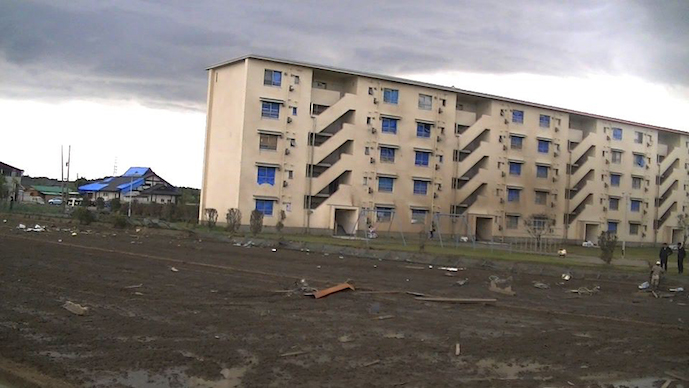English Information:Yusuke SASAKI
Yusuke Sasaki describes his art practice as ‘thinking with film,’ and in this context, his camera is a kind of additional limb. Whether juddering along as he rides his bicycle or sweeping through neighborhoods on a train ride, his camera moves with him, and commits journeys to film like we log memories in our minds.
Sasaki is interested in fukeiron, a movement in Japanese cinema dating from the late sixties, whose name has been translated as ‘landscape theory.’ This movement could be described as a form of political, cinematic psychogeography. Radical spoken soundtracks are often set to shots of everyday landscapes and urban sprawl. One of the movement’s most famous filmmakers and activists, Masao Adachi, described this approach as a filmic interrogation of the landscape, made in order to reveal structures of power and social oppression latent within everyday life. Adachi’s political and formally experimental soundtracks contrast the seemingly dull, rolling shots taken from car and train windows. This kind of juxtaposition and context run throughout Sasaki’s work, currently on show on the 3rd floor of the Garden Hall.

Asphalt, 2013 / Digital video[Reference Image]
Asphalt + Camera-Eye Myth – The Ride (2015) is a video installation in which six wall-mounted screens display a moving landscape shot from a car or train or bicycle (juddering, rolling, sweeping along) in Ibaraki prefecture. We see roadside cafes, housing blocks, vacant lots, and supermarkets. Each screen has a different rhythm, depending on the mode of transport taken. But while different, each shares a temporal space: the screens move together through the four seasons and from morning until dark. Over these shots is broadcast a woman’s voice, very softly reading from a 1910 novel called The Soil, by Takashi Nagatsuka. The novel portrays rural peasant life in Japan during the Meiji era, therefore contrasting the modern asphalt world we see on screen. The losses and gains incurred by modernization seem to play out somewhere in between the words we hear and the scenes we see. Somewhere, perhaps, in the quaking movements of the camera.
A companion piece to this film bears a similar title, Asphalt + Camera-Eye Myth – The Code (2015), and is positioned in the light-filled lobby adjacent to the film installation. This piece comprises three short films available to watch on i-Pads, alongside Sasaki’s own books. Adhered to the floor-length windows near the books and i-Pads, and overlooking the road outside, are several text pieces in Japanese and English. The road outside is a perfect backdrop for their celebration of transport and movement. They provide the ‘code’ for understanding Sasaki’s practice, referring to ‘cycle cinematography,’ ‘traveling shots,’ and the various cinematic rhythms and scales that coincide with those felt when traveling. As visitors move along the window texts, their own motions walking, and the flowing traffic outside, seem to reconstruct what we have just seen on film, activating it in a new context – this week, in Ebisu.